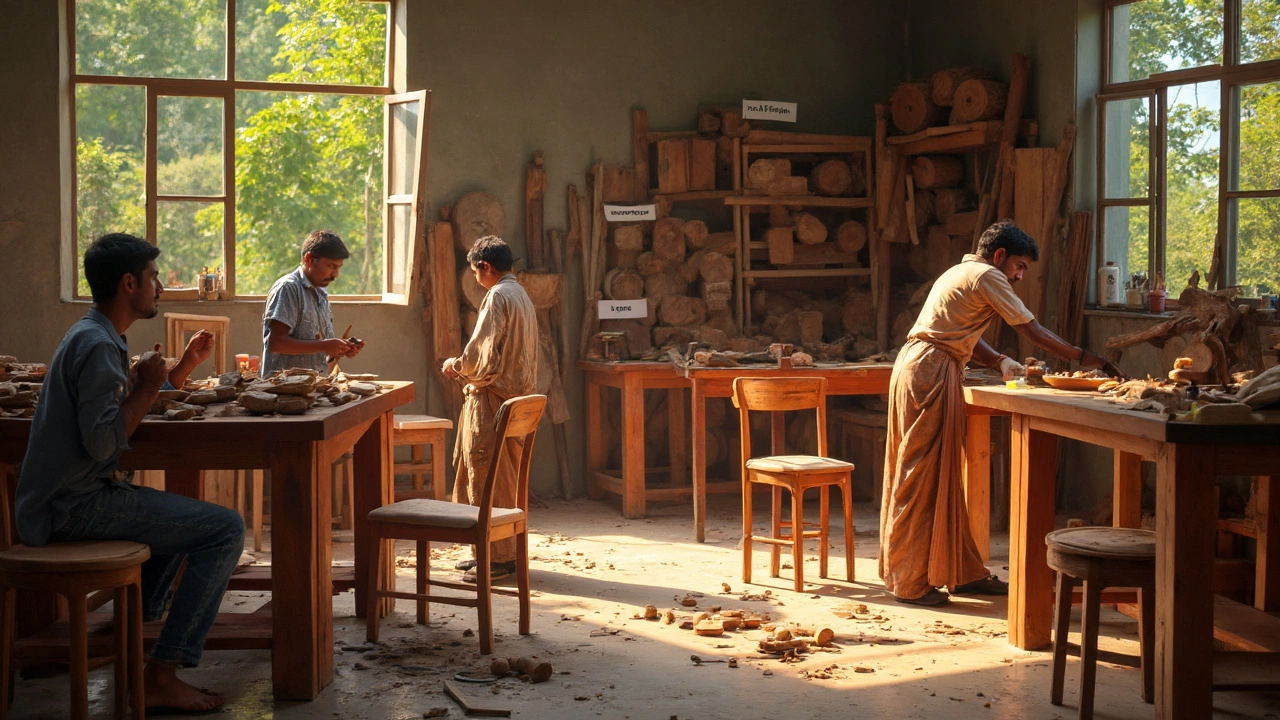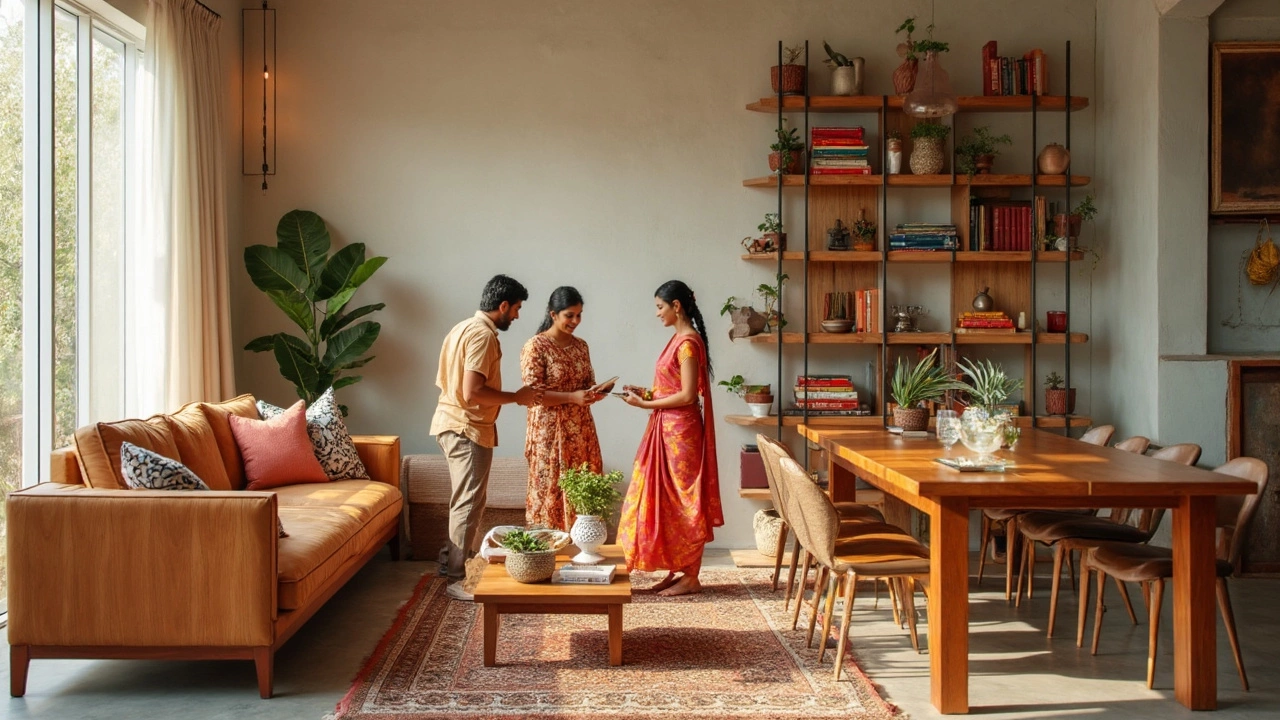Which Wood Is Best for Furniture in India? Top Picks and Tips

If you walk through a busy Indian market or browse online listings, you'll notice furniture everywhere looks so different—sometimes even when it’s all "solid wood." So what’s really inside that bed, table, or cupboard? The wood you choose isn’t just about looks. It decides how long your furniture lasts, how much maintenance you'll need, and even how much money you'll save down the line.
Not all wood is equal, especially in India. Some woods fight off termites like seasoned warriors, while others quickly show scratches or cracks in the monsoon. Teak and sheesham have been around for ages, but people sometimes get tricked by confusing names. Many shops toss around "solid wood" to describe even cheap plywood and MDF. These details matter if you want something that'll survive kids jumping on sofas, or if you’d rather not wake up to creaking sounds from your bed every night.
Let's break down which woods stand up to the Indian lifestyle, why some choices are smarter for different rooms, and the real secrets manufacturers won’t tell you when you start shopping. Good furniture doesn’t have to be crazy expensive—it just needs the right wood in the right place.
- Why the Right Wood Matters
- Popular Woods Used by Indian Furniture Makers
- How to Judge Wood Quality
- Smart Buying Tips for Indian Households
Why the Right Wood Matters
Picking the right wood for furniture isn’t just about style—it’s about whether the stuff you buy will last through India’s wild weather, busy families, and even hungry termites. The climate alone can wreck weak wood. Hot summers, humid monsoons, chilly winters—some woods take it all in stride, while others just fall apart.
The most important thing to keep in mind? Different woods handle daily life in India in really different ways. Teak and sheesham stand up to heat, moisture, and bugs much better than cheaper stuff like mango or pine. You’ll save money in the long run picking something that doesn’t need repairs every year or two.
Here’s what usually happens when people pick the wrong wood:
- Furniture warps or cracks with weather changes.
- Termites munch away inside and you don’t notice until chunks fall off.
- Heavy chairs or beds start creaking and wobbling after a few months.
- Repairs get expensive and sometimes you have to toss the piece entirely.
A fun fact: India imports about 3 million cubic meters of hardwood every year, mainly because local supplies can’t meet quality demands. But there ARE great local options—you just need to know what to look for.
| Wood Type | Main Strength | Weakness |
|---|---|---|
| Teak | Handles water, resists termites, lasts decades | Expensive, sometimes faked with lookalikes |
| Sheesham | Hard, durable, unique patterns | Needs proper seasoning, can crack if not dried well |
| Mango | Affordable, good for light use | Not as strong, softer surface dents easily |
| Pine | Cheap, lightweight | Attracts bugs, warps in humidity |
If you care about your furniture looking sharp and holding together for years, focusing on best wood for furniture India just makes sense. Quality wood fights off bugs, shrugs off spills, and handles every rough day in an Indian home. Spend a little time choosing now, and you don’t have to keep worrying later.
Popular Woods Used by Indian Furniture Makers
There’s a lot more to Indian furniture than just “wood.” Some types hold up for decades, while others start crying at the first sign of moisture or termites. Here’s what actually goes into most Indian homes, and why furniture makers swear by these picks.
- Teak: The most famous choice for Indian furniture, especially for those who want something to pass down. It’s super tough and naturally oily, so it shrugs off water damage and termites. Furniture made from mature, well-seasoned teak can last over 50 years. Expect to pay more, but you’ll rarely regret it.
- Sheesham (Indian Rosewood): This is what you’ll find in loads of shops across Delhi, Jaipur, and Mumbai. Sheesham is hard and looks great with its deep grain patterns. It resists decay, which makes it good for both indoor and outdoor stuff. However, if the wood isn’t dried properly, it might crack or warp over the years.
- Mango Wood: This one’s much cheaper than teak or sheesham and has gained tons of popularity lately. It’s sustainable—because the wood mostly comes from fruit farms after the trees stop bearing—and pretty easy to work with. Just know that it’s softer, so you might see dents if you’re rough with your tables and chairs.
- Sal Wood: Heavy, solid, and mostly used for frames, doors, and heavy-duty furniture in schools and old government buildings. Sal takes a lot of beating but needs serious polishing to stay smooth (it can look a little rough if ignored).
- Plywood and MDF: Strictly speaking, these aren’t pure wood. Plywood is layers glued together, and MDF is made from wood dust. They’re extra cheap, show up in budget furniture, and won’t battle termites for long or hold up like real hardwoods. You’ll often see sellers calling these “engineered woods.”
Here's a quick look at how these woods compare on the most common things buyers care about:
| Wood Type | Durability | Termite Resistance | Common Use | Average Lifespan |
|---|---|---|---|---|
| Teak | Excellent | High | All furniture | 30-50 years |
| Sheesham | Very Good | Good | Beds, tables | 20-30 years |
| Mango | Moderate | Average | Decor, shelves | 10-15 years |
| Sal | High | Good | Frames, doors | 25-40 years |
| Plywood/MDF | Poor to Moderate | Low | Budget furniture | 5-10 years |
Keep in mind, the best wood for furniture in India really depends on your budget, how rough your household is, and whether you want the piece to survive monsoons and insects. And if someone is claiming to sell "pure teak" at a dirt-cheap rate, be a little suspicious. Real hardwoods, especially teak, aren’t cheap unless corners are being cut somewhere.

How to Judge Wood Quality
Buying furniture isn’t just about picking what looks nice. There’s a huge difference between a sturdy piece built for Indian conditions and a pretty piece that falls apart after a couple of years. Here’s how you can actually spot good quality wood before you shell out your money.
Best wood for furniture India is a phrase you’ll hear everywhere, but good quality runs deeper than just a name tag. Start by looking at the wood’s grain. Authentic hardwoods like teak and sheesham have a natural grain pattern that’s hard to copy. If the surface looks too smooth or the pattern repeats perfectly, it’s probably veneered plywood, not actual hardwood.
- Weight matters: Solid hardwood furniture is heavy. If you lift a chair or table and it feels too light, it’s likely hollow or made of MDF—even if the shopkeeper swears it’s real wood.
- Surface check: Run your hand over the surface. Hardwood is never perfectly flat or glossy everywhere. Small imperfections are normal, because natural wood isn’t made in a factory.
- Knock test: Tap the wood. A deep, solid thump means real wood, while a hollow or tinny sound usually means ply or particle board.
It helps to know this stuff:
| Wood Type | Density (kg/m³) | Expected Lifespan (with care) | Common Issues |
|---|---|---|---|
| Teak | 700-900 | 50+ years | Pricey, but extremely durable |
| Sheesham | 775-850 | 35-40 years | May crack if not seasoned |
| Mango Wood | 600-750 | 15-20 years | Softer, can dent |
| Plywood | 400-600 | 5-10 years | Not water/termite resistant |
Don’t just trust a sales pitch of “solid wood” or "engineered wood." Ask about the source—wood from older trees is usually tougher, and seasoned wood resists warping or cracking in Indian weather. Smell the wood if you can; real teak, for example, has a distinct slightly oily scent.
Check for hidden joints, too. Flip the furniture (if possible) and see underneath. Many manufacturers only use real wood for outer parts but fill unseen spots with cheaper stuff. Solid furniture should look and feel the same all over.
Finally, don’t forget about warranties. If the shop or manufacturer is happy to give you a written warranty for at least a few years, it’s a good sign they trust their material. If they dodge the question, it’s probably time to look somewhere else.
Smart Buying Tips for Indian Households
So you’ve settled on buying new furniture and want something that lasts longer than a couple of seasons. Let’s talk strategy—nobody wants to get cheated or end up with something flimsy. If you’re shopping for the best wood for furniture India can offer, it’s good to be sharp and know exactly what to look for before you pay up.
- Always ask what wood is actually used: Don’t just trust a sales pitch. Ask for the name of the wood and if it’s solid, engineered, or veneer. Genuine teak and sheesham are heavy and have distinct grains—you can spot fakes if you pay attention.
- Run your hands over the surface: Solid wood feels smoother and cooler than composite boards. Check joints—screws and bolts should be tight, and there shouldn’t be wobbly spots.
- Watch out for termites and moisture: If you live somewhere humid or have faced termites, go for seasoned wood like teak, which naturally resists these problems.
- Demand detailed bills and brand guarantees: A legit shop will break down pricing (wood, labor, polish) and often give a warranty—don’t skip the paperwork.
- Check the return and repair policy: Furniture shops now offer replacements or home service—even big names like Godrej Interio and Durian have this. Never hurts to ask.
If you’re comparing options and prices, here’s a quick table showing what to expect in 2025 for some popular picks:
| Wood Type | Average Price/Foot (2025) | Termite Resistance | Common Uses |
|---|---|---|---|
| Teak | ₹2,200 - ₹4,500 | High | Beds, doors, outdoor |
| Sheesham (Indian Rosewood) | ₹1,200 - ₹2,800 | Medium-High | Dining, wardrobes |
| Mango | ₹750 - ₹1,500 | Medium | Coffee tables, cabinets |
| Engineered Wood | ₹400 - ₹1,200 | Low | Shelves, budget items |
One last thing: Don’t get pressured into buying just because the shopkeeper says prices will double "soon"—watch for deals during festive sales when big stores clear out older stock with steep discounts. Stay curious, check around, and you’ll end up with sturdy furniture that actually gives you your money’s worth.